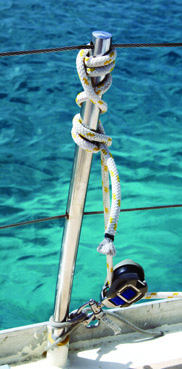Im as prone as anyone to being enchanted by the big picture-but I learned quickly where that can lead. About 10 miles off the coast of Colombia, in a gale that tragically swept a poor French cruiser right off his boat, the smallest cheapest block on board our little ketch exploded in a mess, leaving the club-footed staysail swinging around the foredeck like a Louisville slugger in the arms of an angry Skunk Ape (thats Florida-speak for Big Foot).
The devil is in the details, as they say.
Circumnavigators and sailing writers Beth Leonard and Evans Starzinger did a short piece for us a while back that illustrates my point. The article looked at a seemingly mundane subject, the kind of article no one but a serious sailor would take notice of, but the implications were far reaching.
The topic was gripping hitches. A gripping hitch is the knot you would use to tie one line to another (or itself) when you don’t want the line to slip. Common uses on a boat are securing awnings, taking the load off a jib sheet that is snarled on a winch, or attaching a nylon anchor snubber to take the load off the anchor rode, a topic we explored in-depth In “Rethinking Anchor Snubbers”.
The most familiar knot of this type is a rolling hitch. While an ordinary rolling hitch might work fine on an awning, it loses its effectiveness as loads and rope diameters increase. Beth and Evans rely on a gripping hitch in another critical situation-to form a bridle for their drogue when running before a gale. For this type of use, a rolling-hitch simply wont do.
Now is a good time to review your sailing knots, Ive listed the findings on our gripping hitch test here. If you want to check out more details on the test, you can see our article online in the August 2009 issue, which includes photos and some links that show you how to tie them. We also have report on how gripping hitches perform when attached to chain. Beth and Evans’ articles section of their website also includes tying instructions, as does the website Animated Knots, where you can search for some of these knots by name. If you are really into knots and don’t yet have the mother of all knot books, “The Ashley Book of Knots.
ROLLING HITCH
This classic gripping hitch slipped in all but one of our test situations. After it had been tensioned up, it was always a bit difficult to untie, though it never required a marlinspike.
While it was the most easily tied and most easily remembered, it cannot be relied on for use with anything but chain and large diameter, high-friction line at relatively low loads, in our opinion.
Bottom line: If you want to be sure your line wont slip, don’t rely on the rolling hitch.
MODIFIED ROLLING HITCH
The riggers and camel modifications to the rolling hitch increased its holding power without greatly increasing its complexity. But it still did not hold on slippery, single-braid Spectra line or on the greased stainless tube with the larger diameter line.
Like the rolling hitch, it took some time to undo after it had been loaded up. It would be a good choice for a quick and easy hitch for moderate loads.
Bottom line: A definite improvement over the rolling hitch, but still not reliable in all situations.
SAILORS HITCH

The sailors hitch took twice as long for our testers to tie as the two rolling hitches, and it was the hardest to undo when used with line. After being tensioned on the single-braid Spectra, it took a marlinspike and 10 minutes of hard work to free it. The hitch also slipped when tied with half-inch Dacron line to the greased stainless-steel stanchion.
Bottom line: This hitch does not perform any better than the modified rolling hitch, but it is harder to remember and jams when used with certain types of line.
ICICLE HITCH
The icicle hitch also took twice as long as the rolling hitch to tie, but it performed better than all but the gripper hitch, holding in all test situations.
Though the icicle hitch would separate a bit as it was tensioned, the top of the hitch never moved even with maximum load. This was the easiest hitch to undo after it had been tensioned.
Bottom line: The extra holding power and the ease of release more than make up for the slight increase in complexity of this hitch.
GRIPPER HITCH
While this hitch performed every bit as well as the icicle hitch, and might have outperformed it, had we made the testing even more difficult, its complexity can’t be ignored. It took our testers one-10th the time to tie the various rolling hitches and a quarter the time to tie the sailors or icicle hitches. After a week, it was already difficult to remember, and it would be all but impossible after a month. Even with a lot of practice, this hitch will take longer to tie than any of the others. It also required a spike to undo after being highly tensioned.
Bottom line: The gripper hitch may have the highest holding power, but in an emergency, most people will prefer a hitch they can remember easily and tie quickly.


































